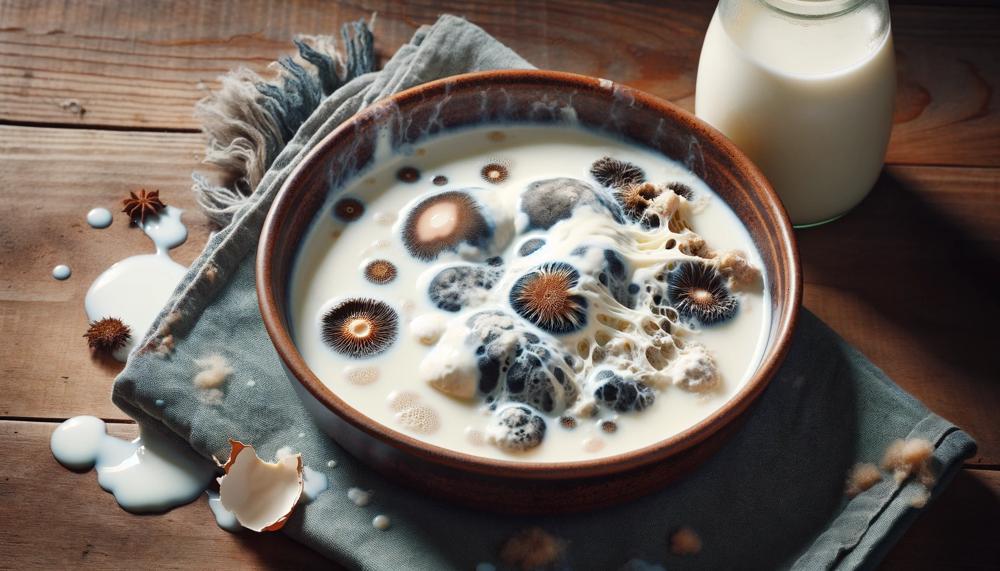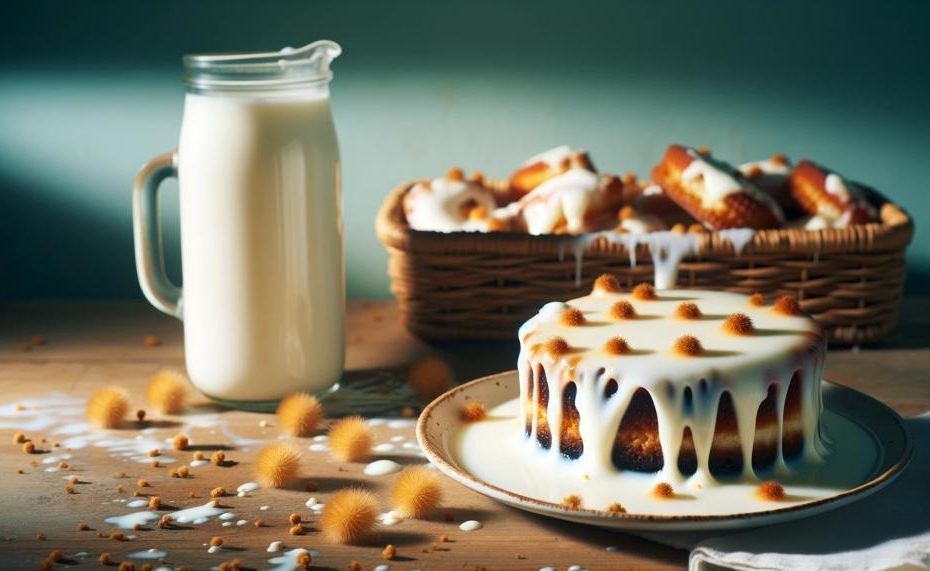Let’s talk about a rather smelly issue that many of us face but might not know the best way to tackle: disposing of spoiled milk. It’s a common household dilemma, and how we deal with it can have a surprisingly significant impact on our environment. Before you think about tipping that sour-smelling milk down the drain, pause and consider some smarter, eco-friendlier alternatives.
In this post, we’re going to dive into the dos and don’ts of milk disposal, ensuring that your actions align with a sustainable lifestyle.
So, how do you dispose of spoiled milk properly?
Here are some ways to dispose of spoiled milk:
- Wrap and throw away: If the milk has mold, green stuff, or white moss, wrap it in a couple of bags and throw it away.
- Pour down the toilet: If the milk is only a couple days old, you can pour it down the toilet.
- Compost: If you have more than two liters of milk, you can put small amounts in your compost every day.
- Recycle: If the container is recyclable, you can dump it down the sink, rinse the container, and put it in recycling.
Spoken milk is also suitable for use in salad dressings, baked items, soups, and casseroles. You may use it in lieu of sour cream or buttermilk, for instance. If you think the scent is too strong, you may combine it with other aromatic components or essential oils.
Diarrhea, cramping in the stomach, or nausea may all result from spoiled milk. It is less likely that you will get ill, however, since the heat from the oven kills the majority of the dangerous germs.
So, let’s get started and turn that frown upside down – spoiled milk doesn’t have to be a bummer.
Contents
Do Not Pour Spoiled Milk Down The Drain
Disposing of spoiled milk responsibly is crucial to protect our environment and aquatic life. Here’s a straightforward guide to doing so:
Alternative Uses for Spoiled Milk

- Homemade Cheese: Spoiled milk can be used to make cheese. Acidic milk helps coagulate the proteins.
- Baking Ingredient: It can be an ingredient in baked goods like scones or pancakes.
- Pet Food: Small quantities can be mixed with pet food.
- Plant Fertilizer: Diluted spoiled milk can nourish plants.
- Meat Tenderizer: It contains lactic acid, which tenderizes meat.
Storage and Disposal Tips
- Freeze for Later: Freeze curdled milk for future use in cooking.
- Compost: Add to a compost bin as it’s biodegradable.
- Solid Waste: Let it solidify and dispose of it with regular trash.
Avoiding Spoilage
- Proper Storage: Keep milk refrigerated and tightly sealed.
- Track Expiration: Monitor and use milk before its expiry date.
- Buy Smaller Quantities: Prevent waste by buying only what you need.
Using these methods, you can avoid harming the environment while finding useful applications for spoiled milk.
| Method | Usage | Benefits |
| Homemade Cheese | Making cheese | Utilizes high acid content |
| Baking Ingredient | Incorporate in baked goods | Enhances flavour |
| Pet Food | Mix with pet food | Supplements diet |
| Plant Fertilizer | Feed to plants | Nourishes soil |
| Meat Tenderizer | Use in marinating | Softens meat |
Do Not Flush Spoiled Milk Down The Toilet
Disposing of spoiled milk requires a touch of common sense and a pinch of creativity, lest we harm our blue planet and its myriad dwellers. Flushing it down the toilet, though seemingly an easy out, is a no-go area.
Why Not the Loo, Mate?
Simply put, our sewage systems and water treatment facilities aren’t designed to handle high volumes of dairy products. Spoiled milk can upset the delicate balance of the water treatment process, leading to pollution and harm to aquatic life.
Not to mention, in some locales, you could be fined for such actions due to the environmental impact.
Proper Disposal and Reuse Ideas
Instead of giving it a watery grave, consider these options:
- Baking and Cooking: Spoiled milk can still star in your scones, pancakes, or homemade cheese adventures. Its acidity can tenderize meats and add a tang to baked goods.
- Garden Aid: Acid-loving plants may appreciate a diluted milk treat. Just ensure it’s mixed with a lot of water to avoid overpowering smells or attracting unwanted pests.
- Pet Food: Some pets can handle a bit of sour milk without a fuss. However, this is pet-dependent and should be approached with caution.
- Freeze It: If you can’t use it immediately, freeze spoiled milk for later use in cooking or gardening.
| Do | Don’t | Why |
| Use in baking | Flush down the toilet | Protects water treatment processes |
| Feed to plants (diluted) | Pour down the sink | Prevents environmental harm |
| Consider as pet food | Dispose of carelessly | Avoids fines and pollution |
How To Dispose Of Spoiled Milk
Disposing of spoiled milk needs care to prevent health hazards and environmental issues.
Recognising Spoiled Milk:
Start by spotting the milk that’s turned. Look for a sour scent, curdling, or an expired date.
Don’t Cook or Drink:
Tempting as it might be, avoid using the spoiled milk in recipes or drinking it to avoid illness.
Avoid the Drain:
Pouring milk down the sink might seem easy, but it’s a no-go. It can clog and harm the environment.
Seal and Bin:
Pour the milk into a container that seals well to stop bacteria and odours from escaping. Pop it in the rubbish bin.
Local Rules Matter:
Each place has its own disposal do’s and don’ts. Make sure to stick to your area’s guidelines.
Composting Option:
If it’s possible, composting the spoiled milk can be a green choice, transforming waste into something useful for plants.
Clean-up Operation:
Any area or container that touched the bad milk needs a good wash to avoid spreading unwanted germs.
Is Disposing Of Spoiled Milk Through The Drain Illegal?
Disposing of spoiled milk through the drain is not universally illegal but is highly discouraged due to its negative environmental impact and potential legal repercussions in certain jurisdictions.
Spoiled milk contains harmful bacteria that can contribute to water pollution, affecting aquatic life and ecosystems.
Environmental Implications:
- Pollution: Spoiled milk introduces harmful bacteria into water systems, which can lead to oxygen depletion, harming aquatic fauna.
- Ecosystem Disruption: The introduction of pollutants like spoiled milk into waterways can disrupt local ecosystems, affecting both plant and animal life.
Legal Implications:
- Regulations: In some regions, specific laws prohibit the disposal of dairy products down the drain to prevent environmental harm.
- Fines: Businesses and individuals may face fines if found violating local regulations regarding the disposal of spoiled milk.
Alternative Disposal Methods:
- Composting: Spoiled milk can be added to a compost bin, contributing valuable nutrients.
- Repurposing: Curdled milk can be used to make homemade cheese or as an ingredient in baking, providing a sustainable alternative to disposal.
Storing Curdled Milk
The best methods for storing curdled milk to prevent it from spoiling and ensure its safe disposal involve simple yet effective strategies. Here’s how to handle curdled milk with care:
Keep it Chilled:
Store curdled milk in the fridge right away. The cold temperature slows down the growth of harmful bacteria, keeping it safe for a while.
Airtight Containers:
Use an airtight container to store curdled milk. This prevents it from absorbing odors from other foods and also stops the spread of bacteria.
Label and Date:
Mark the container with the date of storage. Curdled milk should be used or disposed of within 3-5 days to avoid health risks.
Safe Disposal Tips:
If you decide it’s time to dispose of the curdled milk, consider environmentally friendly methods. Composting is a great option, as the milk can add valuable nutrients to your compost pile.
Alternative Uses:
Before disposing of curdled milk, consider its potential uses. It can be an excellent ingredient in baking, adding a tender texture to cakes and bread.
| Storage Action | Details | Reason |
| Chill Immediately | Refrigerate at 4°C or lower | Slows bacterial growth |
| Airtight Container | Prevents odor absorption and bacterial spread | Maintains purity and safety |
| Label with Date | Use or dispose within 3-5 days | Ensures safety and freshness |
| Composting | Environmentally friendly disposal | Recycles nutrients back into the soil |
| Use in Baking | Substitute for buttermilk in recipes | Enhances texture and taste of baked goods |
Conclusion
Handling the disposal of spoilt milk while keeping sustainability in mind may turn an otherwise unpleasant situation into one that is good for the environment. Consider using more considerate disposal techniques rather to just throwing things down the drain, which puts our water systems and aquatic life at danger. When treated creatively and with care for the environment, spoiled milk, with its latent potential, may become a valuable resource.
One exceptional option is composting, which converts garbage into a nutrient-rich soil enhancer and illustrates a harmonic cycle of giving back to the environment. On the other hand, using spoilt milk as an organic cleanser or plant food demonstrates how useful it is for purposes other than garbage. Green garbage initiatives may also be available in communities, offering a simple route to responsible disposal.
The transformation of spoilt milk from an annoyance to food serves as a metaphor for a larger idea of mindful living. It’s a call to action for everyone involved in the wellbeing of our world, not only environmentalists. Mitigating the effect on the environment begins with every decision to redirect spoilt milk from the drain to more environmentally friendly channels.





